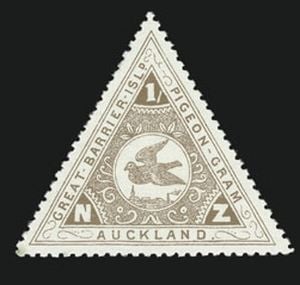This New Zealand Island’s Pigeon Mail Stamps Are Still Prized
Pigeons carried correspondence between Great Barrier Island and the New Zealand mainland for about a decade in the early 20th century
/https://tf-cmsv2-smithsonianmag-media.s3.amazonaws.com/filer/3e/23/3e23e78f-abc2-4152-80bf-45d534c26988/pigeongram.jpg)
Pigeons might just be an urban nuisance today, but once upon a time, trained pigeons helped change a small corner of the world.
That corner was New Zealand's Great Barrier Island, an island about 60 miles away from the mainland city of Auckland. A pigeon post service flourished there for almost a decade, being one of the first and only commercial pigeon post services. Several competing pigeon posts that served the island during these years also bear the distinction of being likely the first service in the world to produce a stamp specifically for airmail use, in November 1898. Over time, stamps from the pigeon post have become prized by collectors.
The pigeon post was, for about a decade, the only means of communication between Great Barrier Island and the mainland, except for a weekly ship visit. A few years before it was established, in 1894, a steamship named the S.S. Wairarapa, en route from Sydney to Auckland, broke up on a reef near the island and sank. More than 140 passengers died, yet it took three days for news of the wreck to reach Auckland, the ship’s destination.
The island clearly needed a better means of communicating with the mainland, but the idea for a pigeon post didn’t arise for another two years, writes Margo White for New Zealand Geographic. In 1896, a New Zealand Herald reporter who was attending an anniversary service for the deadly event filed his story to the mainland using a pigeon named Ariel, writes White. It took Ariel, who was owned by an Auckland pigeon fancier named Walter Fricker, took less than two hours to reach the mainland.
This event sparked a long tradition of pigeon mail to the island. Fricker started the Great Barrier Pigeongram Service in 1897, according to Barth Healey writing for The New York Times.
“Free enterprise being what it is, Fricker was immediately challenged by J. E. Parkin, who opened a ‘Great Barrier Postal Pigeon Service,’” Healey wrote. “Parkin was chastised by the authorities for using ‘postal,’ so he dropped it in favor of ‘pigeongram,’ causing confusion with Fricker's service. Finally, S. H. Howie weighed in with ‘The Original Great Barrier Pigeongram Service,’ which of course it wasn't.”

With all these competing entrepreneurs, it took a while to get everything sorted out. In 1898 and 1899, the competing services began to use stamps of various designs. These were likely the world’s first airmail stamps, writes White. The pigeon post services continued to play out their drama (Parkin dropped out in 1899) until 1908, when underwater telegraph cables enabled telegraph service to the mainland.
The Great Barrier Island pigeon post and other late 1800s attempts at using pigeons for regular postal messengers offers a fascinating glimpse into communication when the telegraph was just being developed. The stamps offered by the competing services have become collector’s items, reflecting their unique value. "Only a small proportion of the stamps were ever flown; many were ruined by poor storage and a good number snapped up by eager philatelists," writes White. As a result the remaining stamps of the eight designs that were produced are worth many times their original value.